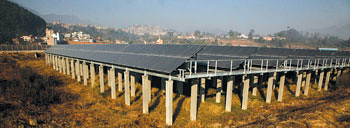Nepal can cash in on solar power while waiting for hydroelectric projects to come up

MIN RATNA BAJRACHARYA
If all the electricity generated by private solar cells in Nepal’s urban areas is added up, it would total 200MW of electricity: more than
Kali Gandaki IIA, Nepal’s biggest hydropower plant. But officials at the main power utility in the country, Nepal Electricity Authority (NEA), still don’t believe solar power is feasible even when most of its customers have switched to solar because of the shortage of hydro. One NEA executive told a conference last week: “Solar power is just ornamental.”
After being badgered, NEA finally agreed last year to test a solar system to feed surplus daytime power into the grid through a system called net metering. The Kathmandu-based Centre for Energy Studies collaborated with the Swiss university SUPSI and successfully integrated grid-connected 1KW solar photovoltaic systems each at Pulchok Engineering Campus and the Rural Integrated Development Services (RIDS) Nepal and 3KW system at NEA’s office in Baneswor.
Solar activists were also happy when NEA added sun power from the Sundarighat system (pic, above) to the national grid in January. The 680KW Japanese-built plant generates solar power for water treatment by the Kathmandu Valley Drinking Water Limited and feeds the surplus into the grid. The head of NEA’s Power Trade Division, Sher Singh Bhat, is still not convinced.
“Solar energy is not commercially feasible and reverse metering is not viable because the lack of stable electricity supply means surplus solar power from households cannot be fed into the national grid. Besides not everyone can afford to install large systems above 1KW.”
Promoters of solar like Professor Jagan Nath Shrestha from Pulchok Engineering Campus which successfully demonstrated reverse metering, refutes these arguments. He says there have be other alternatives like solar while Nepali consumers wait another five years for sufficient hydro-electricity.
“People are energy starved now and are paying up to Rs 30 per unit for diesel generated electricity, why wouldn’t they pay half of that for solar? It’s not about being green, it is a necessity,” he says. He estimates that 72 gigawatt hours of power could be generated from just 10 per cent of Kathmandu’s total area. If power generated by individual rooftop panels in urban areas of Nepal is added up, it would amount to 200MW of electricity. NEA’s excuse that there are technical hurdles also doesn’t hold water, experts say.
“NEA can easily buy surplus solar energy through reverse metering wherever they have dedicated feeders and encourage people to install solar panels,” explains Ram Prasad Dhital, assistant director at the Alternative Energy Promotion Centre (AEPC), which has been advocating subsidies for alternative energy. Dhital says that although the initial investment for solar power is high, so are the long-term returns.
NEA’s Sher Singh Bhat, however, sticks to his argument that hydro energy is the only way ahead. He says power cuts will be history once Upper Tama Kosi (456MW) is completed in four years and hydropower will be much cheaper than solar. “We are also working with India to construct cross border high capacity line to import electricity to manage demand here until these larger projects are completed,” says Bhat. This is the kind of argument that drives solar promoters up the wall.
“Yes, Tama Kosi is great, but by the time it is built demand will have risen by another 600MW. And what are we going to do till then?” asks Raj Kumar Thapa of Solar Solutions. He says the global price for photo voltaic cells has crashed and the cost per watt of solar power is going to go below $1.
“The technology is getting cheaper by the day and we have the expertise. NEA could easily formulate policies to encourage people to become independent electricity producers and buy power from them,” Thapa adds.
NEA insiders say the true reason for reluctance to install reverse metering is the pilferage, meter tampering, and corruption which the utility’s powerful unions don’t want to change. Former water resource minister Dipak Gyawali, who tried and failed 10 years ago to introduce time-of-day metering to reduce peak demand and also net metering, says: “There are institutional barriers to change and unless we unbundle generation, distribution, and transmission, there will be no answers.”
The power shortage has increased demand for diesel and Nepal now imports Rs 93 billion worth of petroleum products a year from India: more than its total commodity exports of Rs 74 billion. An estimated 550MW of captive power is generated from diesel plants run by industries, hotels, and factories.
Jagan Nath Shrestha can’t hide his frustration: “I was 10 when I first heard about how Nepal would sell electricity to India and become rich. I am now 63 and we have 14-hour power cuts daily. How much longer are we going to wait?”
See also:
Bring home the sunshine
Rabi rocks